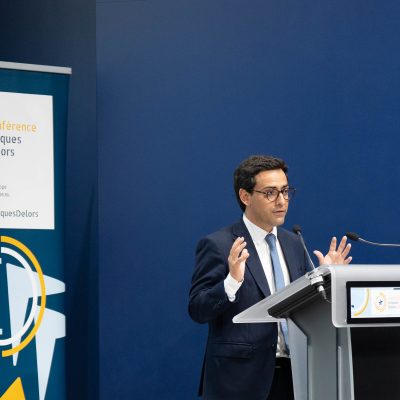
Ce document d’orientation reflète les conclusions de l’auteure dans sa thèse finale du programme de master en droit européen au Collège d’Europe. Elle tient à remercier le professeur Dominik Hanf (son directeur de thèse), M. Julien Tribout (assistant universitaire au Collège d’Europe) et les fonctionnaires des institutions européennes qui lui ont consacré leur temps et lui ont fait part de leurs réflexions. Elle remercie également la Fundación La Caixa, qui lui a permis d’obtenir ce diplôme, et l’Institut Jacques Delors, qui a jugé ce document digne du prix de la meilleure thèse sur un sujet lié à l’intégration européenne. Elle remercie tout particulièrement M. Andreas Eisl pour le temps qu’il lui a consacré, la confiance qu’il a accordée à ce travail, sa lecture attentive et ses commentaires très précieux.
Si l’émission d’une dette commune fait partie des outils dont l’UE dispose depuis la Communauté européenne du charbon et de l’acier, le sujet n’est revenu que récemment au centre du débat public. D’abord, la pandémie a apporté une nouveauté en matière d’opérations d’emprunt, à savoir la possibilité de financer les dépenses communes de l’UE. Ensuite, la guerre en Ukraine a conduit l’UE à recourir à des emprunts communs afin de fournir à l’Ukraine une assistance macro-financière.
La conception juridique de ces opérations est en elle-même remarquable, en particulier compte tenu de la conviction passée et très répandue que l’UE ne pouvait pas emprunter des fonds pour financer ses propres dépenses. Néanmoins, le cadre juridique qui régit l’emprunt commun, telle que nous le concevons aujourd’hui, ne nous permettra pas de relever l’ensemble des défis à venir. Par exemple, les règles européennes de prudence financière freinent le versement des aides accordées à l’Ukraine, alors que le pays en a urgemment besoin. De plus, la possibilité pour l’UE de recourir une nouvelle fois à des emprunts communs pour des dépenses est davantage limitée depuis l’approbation de NextGenerationEU, à cause de l’introduction d’une interdiction explicite d’emprunter des fonds sur les marchés pour le financement de dépenses opérationnelles dans la modification en 2020 de la décision sur les ressources propres.
Ainsi, ce policy paper s’intéresse d’un point de vue juridique aux défis futurs en matière d’emprunt commun. Il traite en particulier du niveau de prudence que l’UE devrait adopter lorsqu’elle a recours à de telles opérations, et aborde également la question de l’avenir de l’emprunt pour les dépenses.
Pour ce faire, nous nous pencherons d’abord sur la nature juridique des exigences en matière d’équilibre budgétaire et de discipline fiscale, examinerons leur évolution dans le temps, et comparerons leur application à l’émission de dette commune dans l’UE et aux États-Unis. Dans la perspective de guider les futures opérations d’emprunt, nous nous attacherons ensuite à identifier l’ensemble des règles et principes en vigueur dans l’UE en matière d’emprunt, et en proposerons une catégorisation fondée sur l’étape de l’opération à laquelle ils interviennent (émission, autorisation d’emprunt, et utilisation des fonds). Enfin, nous analyserons les spécificités de l’emprunt pour les dépenses, notamment les conséquences de son interdiction dans la dernière décision sur les ressources propres de l’UE. Lorsque cela est possible, nous soumettrons des interprétations alternatives à même d’offrir de nouvelles perspectives quant au recours à l’emprunt commun ou bien d’accélérer la procédure d’assistance financière à l’Ukraine.




